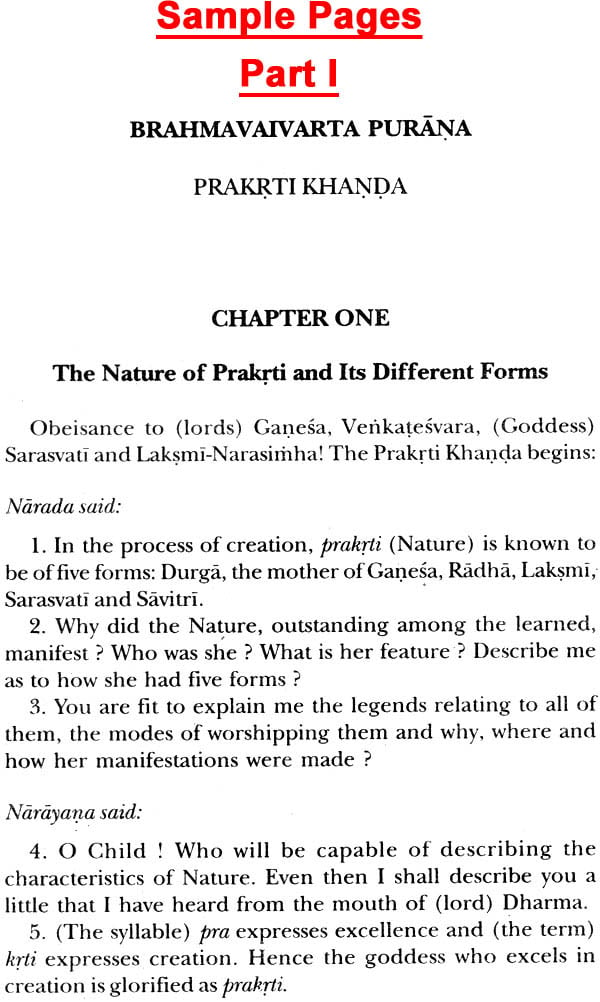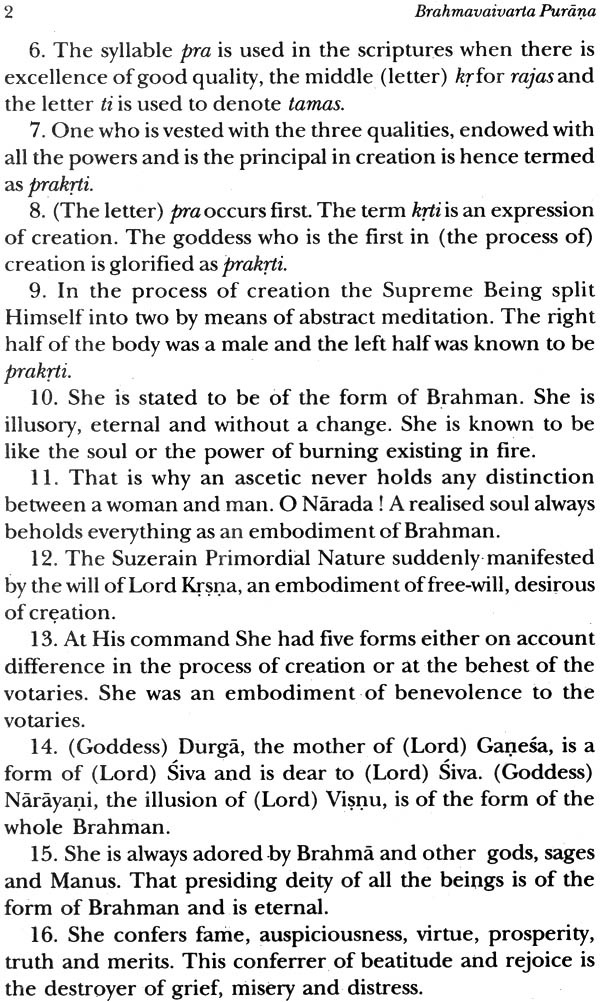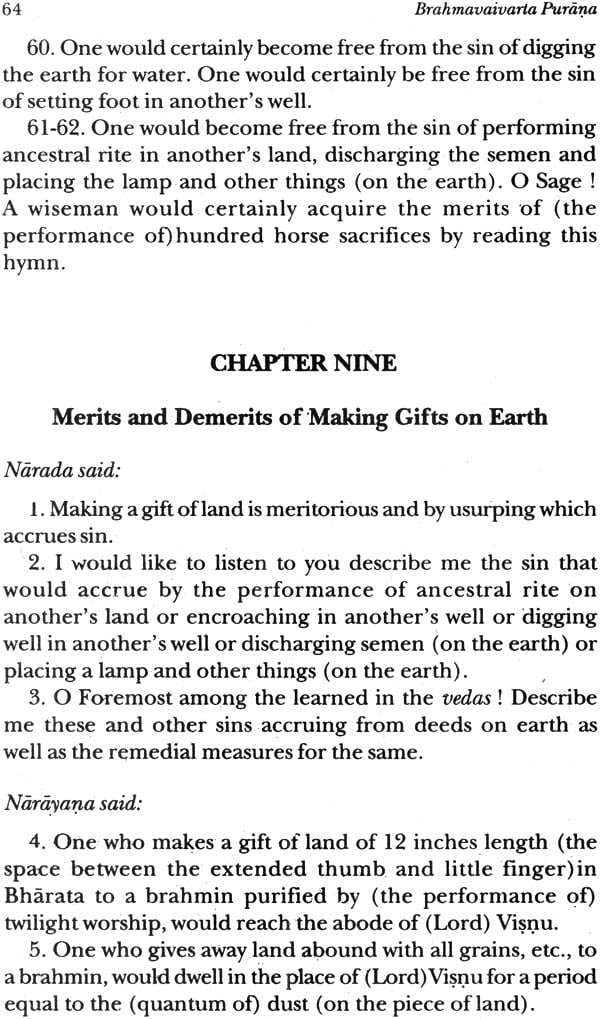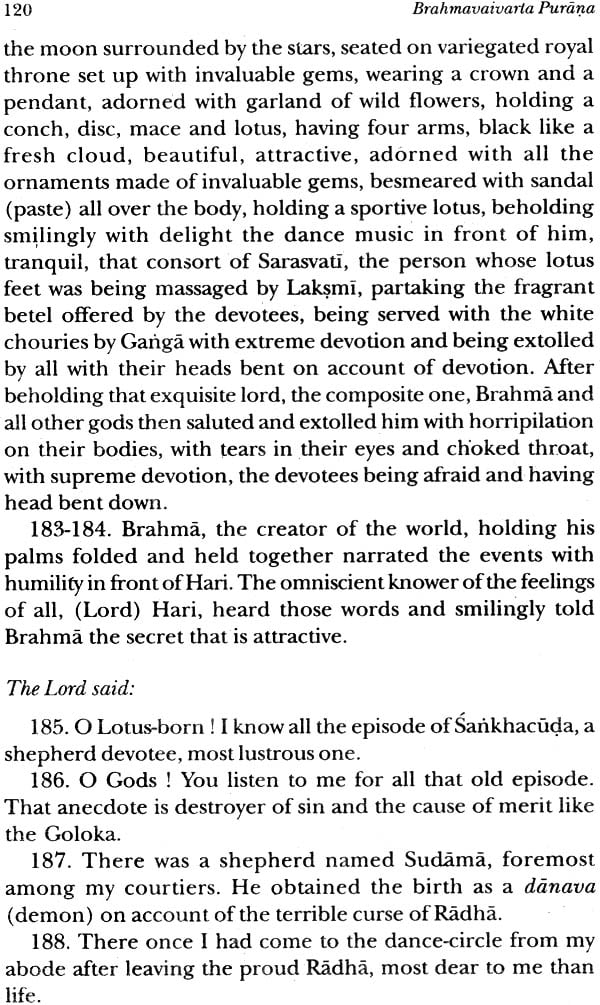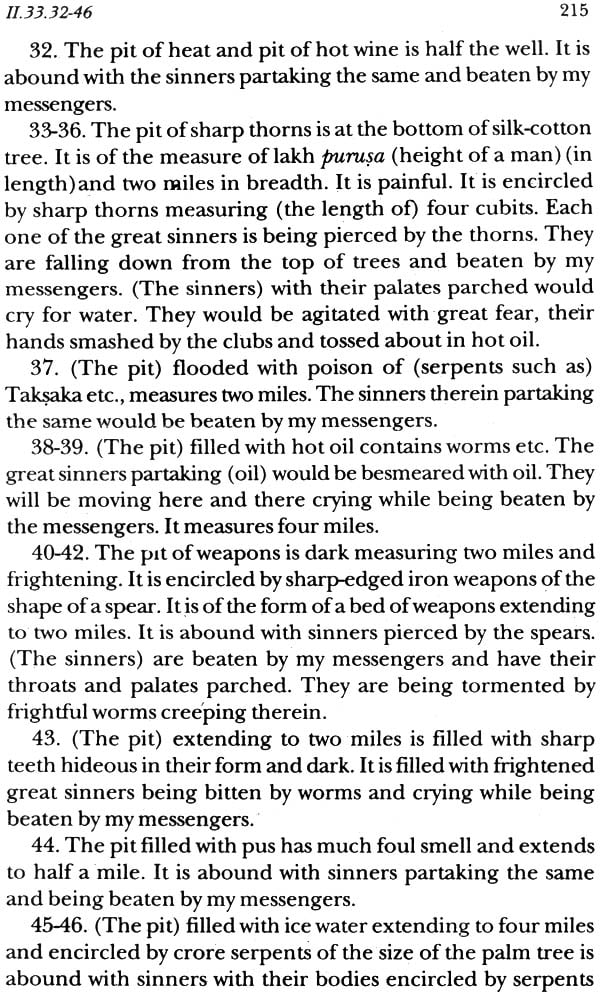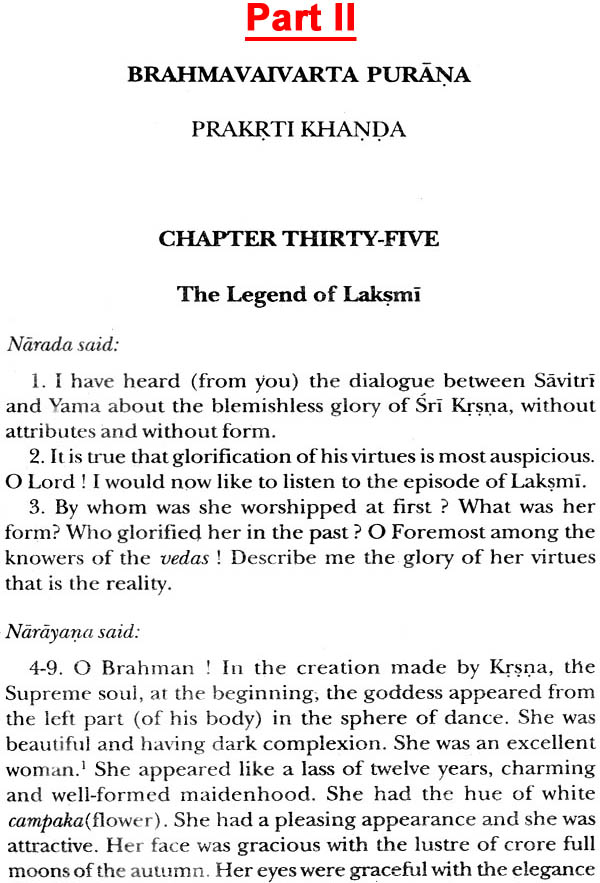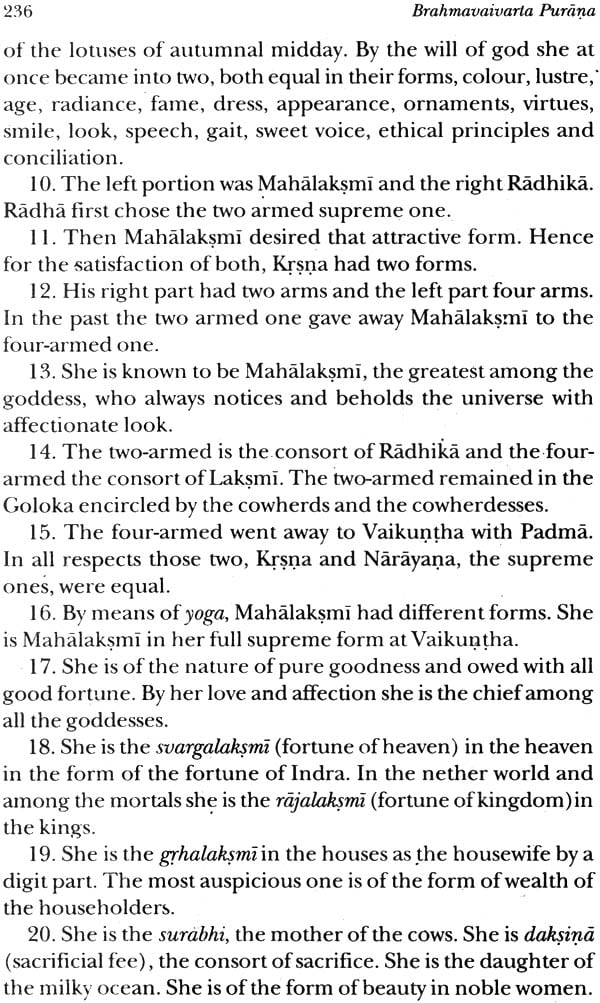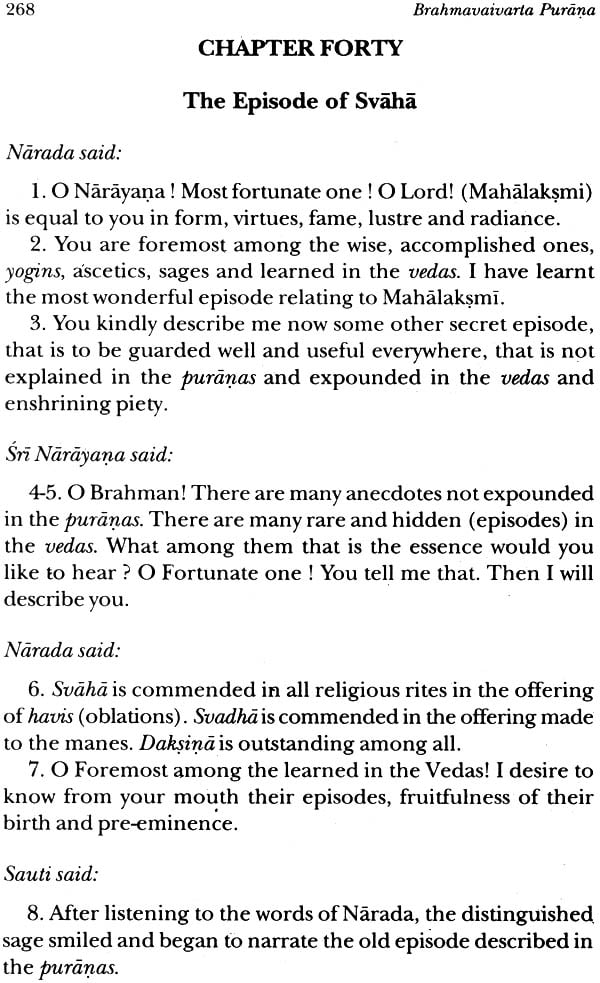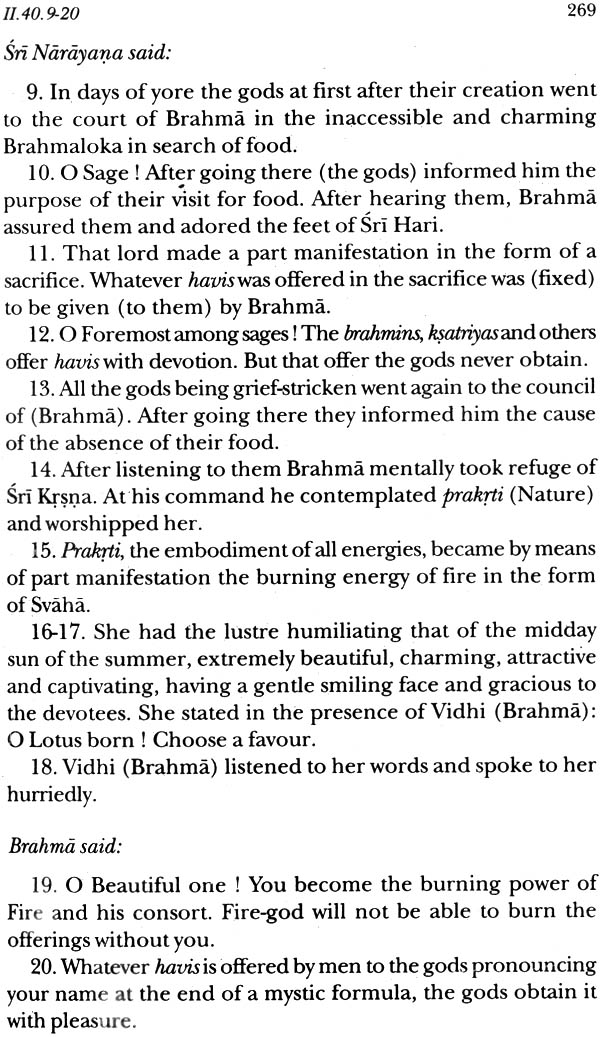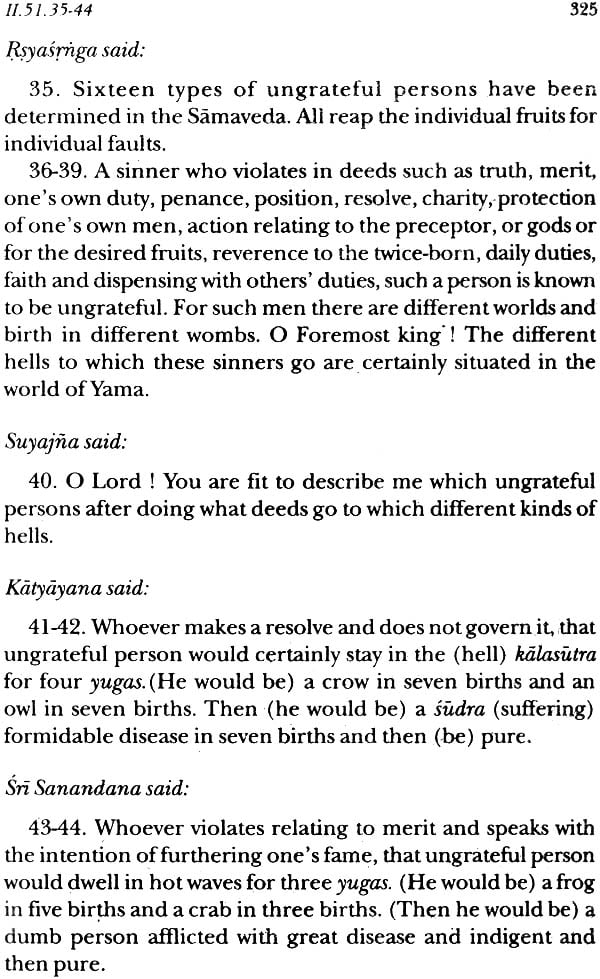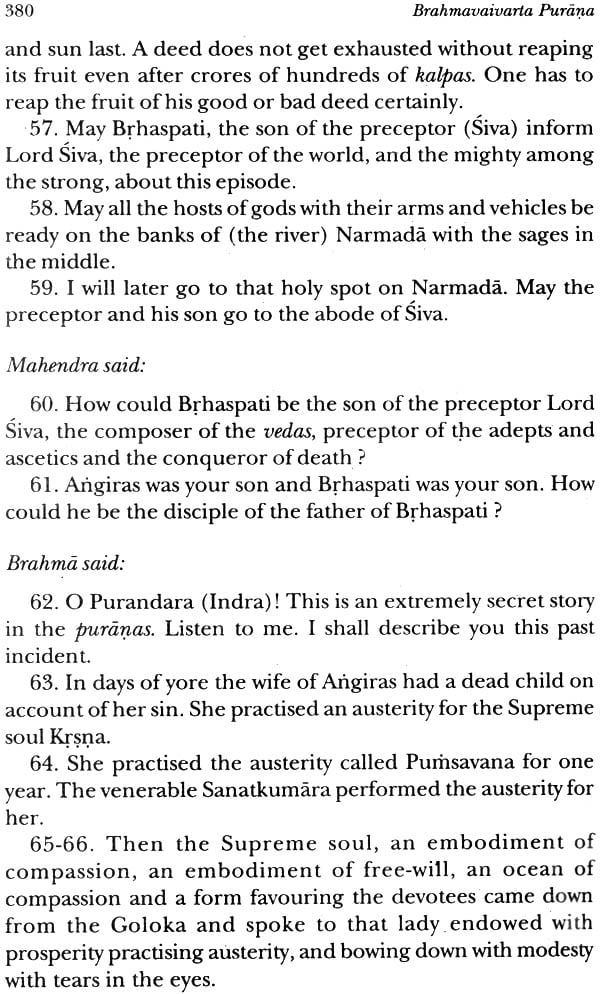
Brahmavaivarta Purana: Prakrti Khanda (Part II in 2 Volumes)
Book Specification
| Item Code: | NAN252 |
| Author: | G. P. Bhatt |
| Publisher: | Motilal Banarsidass Publishers Pvt. Ltd. |
| Language: | English |
| Edition: | 2017 |
| ISBN: | Part I: 9788120840317 Part II: 9788120840324 |
| Pages: | 474 |
| Cover: | Hardcover |
| Other Details | 9.0 inch X 6.0 inch |
| Weight | 870 gm |
Book Description
Brahmavaivartapurana figures as the tenth in the traditional list of the Puranas. It is divided into four parts called khandas, comprising 267 chapters. The khandas are: Brahmakhanda: 30 chapters, Prakrtikhanda: 67 chapters, Ganapatikhanda: 46 chapters and Srikrsnajanmakhanda 133 chapters.
It is well known that the Brahmavaivarta is a Vaisnavite Purana and the sole objective of the work is to glorify the life and achievements of Sri Krsna, an incarnation of Visnu and his Sakti Radha. Many episodes and topics have been interwoven to embellish the main theme of the work. In this Purana, Krsna is not simply an incarnation, he is far superior to and even creator of Prakrti. He is God above all gods.
Part I, i.e., Brahmakhanda deals with the creation of the universe including the gods and animate and inanimate beings by Brahman, the creator God, who is, according to this Purana, none other than a manifestation of Krsna and acts under the guidance of the latter.
Part II, i.e., Prahrtikhanda deals with Prakrti, the primordial matter. According to this Purana, Prakrti is not inert as she is conceived by the Sankhya philosophy, but is intelligent; she is the primary goddess of creation. In compliance with Krsna’s desire, she is manifested as the five goddesses, viz., Durga, Radha, Laksmi, Sarasvati, and Savitri. Many stories about these deities have been narrated and rituals for their worship described in this part.
Part III, i.e., Ganapatikhanda narrates many legends about Ganesa, the elephant- headed god, widely worshipped throughout India and even outside. Though named Ganapatikhanda, this part deals with the birth and life of both sons of Siva, viz., Ganesa and Skanda Karttikeya. According to this Purana, Ganesa is also a manifestation of Krsna. Hence, there is no mention of Ganapatya sects who worshipped Ganesa as the Supreme Godhead. The variations in the images of this deity, found in literature and on icons find no mention in the Purana.
Part IV, i.e., Srikrsnajanmakhanda is the most important of all books of this Purana. It deals not only with the birth of Krsna, as signified by the title, but also his whole life, especially his battles and love dalliances with the cowherdesses (gopis), in particular, with Radha. Radha, who is not even mentioned in the major Vaisnava Puranas like Bhagavata, Visnu, and Harivamsa, has risen in this Purana, to a great importance. It is interesting to note that she is depicted here as a married wife of Krsna.
It is believed that the study of the Puranas is beneficial to the knowledge of the vedas. As the Mahabharata states, the veda should be supplemented with the Itihasa and Purana, for the veda is afraid of being hurt by a person who is not well versed (in the mythological and traditional lore). The traditionalists take the word Purana to mean the Puranic texts like Matsya, Kurma, etc. and attach to them great authority and veneration. They hold that the Puranic texts are repositories of very ancient knowledge because they have been referred to in the Brhadaranyaka Upanisad. Modern Scholars dispute this claim and say that not the extant Puranic texts but some parts of the Vedas which preserve very old traditions, alluded to in other places of the vedas, are referred to in the. Brhadaranyaka Upanisad, as the Purana. They quote, in support of their thesis, Sankaracarya’s interpretation of the said passage of the Brhadaranyaka Upanisad: "Mythology, such as "The universe was in the beginning unmanifest etc."
It is true that the extant Purana texts are much posterior to the early Upanisads and, hence, could not have been referred to in the Brhadaranyaka Upanisad. But this position does not reduce the usefulness and authority of the puranas. The Purana is not a particular set of texts, it is a branch of ancient Indian learning, a class of ancient Indian literature. The nucleus of this branch of class existed in the body of the vedas, which gradually developed into the Puranasamhita and then into the present Mahapurana, Upapuranas, and later apocrypha. The authority of the Purana, as mentioned in the Mahabharata, is vested in this whole class. In this way, we can reconcile the interpretation of Sankaracarya with the classical five characteristics of the Puranas, e.g. primary creation (sarga), dissolution (pratisarga), genealogy (vamsa), ages of Manus (manvantara) and history of Royal dynasties and some illustrious personages (vamsanucarita).
There is no controversy about Brahmavaivartapuranas being a major Purana (Mahapurana).
The Brahmavaivartapurana figures as the tenth in the traditional lists of the Puranas.
The Brahmavaivartapurana is divided into four parts called khandas, comprising 267 chapters. The khandas are: Brahmakhanda: 30 chapters, Prakrtikhanda: 67 chapters, Ganapatikhanda: 46 chapters and Srikrsnajanmakhanda: 133 chapters.
The Matsya and Naradapurana describe the total number of verses of the Brahmavaivartapurana as 18,000. The Brahmavaivarta itself mentions the same number. But the actual counting of the verses of the Purana, now available, gives a total of little over 20,500 verses.
The Brahmavaivarta rejects the traditional five characteristics as covering the Upapuranas only and holds that ten topics are dealt with in a Mahapurana: they are primary creation (sristi), secondary creation (palana), stability of the creation (sthiti), protection (palana), desire for work (karmavasana), information about different Manus (moksa-varta), description of the final destruction of the world (pralaya-varta), showing’ the way to emancipation (moksa nirupana),discourses on Hari (Harikirtana), and discourses on other gods (devakirtana). The purpose of this substitution of list of topics in the Bhagavata and Brahmavaivarta has been discussed by Dr. R. C. Hazra and his opinion on this point deserves serious consideration.
A Complete table of contents (anukramanika) is included in the chapter 132 of the srikrsnajanmakhanda.
It is well known that the Brahmavaivarta is a Vaisnavite Purana and the sole objective of the work is to glorify the life achievements of Sri Krsna, an incarnation of Visnu and Sakti Radha. Many episodes and topics have been interwoven to embellish the main theme of the work. In this purana, Krsna is not simply an incarnation, he is far superior id even creator of Prakrti. He is God above all gods.
Part I, i.e., Brahmakhanda deals with the creation of the universe including the gods and animate and inanimate beings by Brahman, the creator God, who is, according to this Purana, e other than a manifestation of Krsna and acts under the guidance of the latter.
Part II, i.e., Prakrtikhanda deals with Prakrti, the primordial matter. According to this Purana, Prakrti is not inert as she is conceived by the Sankhya philosophy, but is intelligent; she is primary goddess of creation. In compliance with Krsna’s desire, she is manifested as the five goddesses, viz. Durga, Radha, Laksmi, Saraswati, and Savitri. Many stories about these deities have been narrated and rituals for their worship described in this part.
Part III, i.e., Ganapatikhanda narrates many legends about Ganesa, the elephant-headed god, widely worshipped throughout India and even outside. Though named Ganapatikhanda, this deals with the birth and life of both sons of Siva, viz. Ganesa and Skanda Karttikeya, According to this Purana, Ganesa is a manifestation of Krsna, Hence, there is no mention of Ganapatya sects who worshipped Ganesa as the Supreme head. The variations in the images of this deity, found in literature and on icons find no mention in the Purana.
Part IV, i.e., Srikrsnajanmakhanda is the most important of books of this Purana. It deals not only with the birth of a, as signified by the title, but also his whole life, especially battles and love dalliances with the cowherdesses (gopis), Particular, with Radha. Radha, who is not even mentioned the major Vaisnava Puranas like Bhagavata, Visnu, and Harivamsa has risen in this Purana, to a great importance, It is interesting to note that she is depicted here as a married wife of Krsna.
Authority of the Text
Much can be discussed about the authority of extant Brahmavaivartapurana. The authority of the Purana is apparently established, because it is mentioned in older texts Matsya, Narada, etc. But there exists a great discrepancy between the Brahmavaivarta as mentioned in the Matsya and Narada purana and the text that is available now. The Matsyapurana says that the story of the Brahmavaivarta has been narrated by Savarni to Narada, it includes the episode of Brahmavaraha, and it comprises 18,000 verses. But, we do not find even the name of Savarni in the Brahmavaivarta now extant, nor the episode of Brahmavaraha can be traced to it. It can, therefore, be inferred that the original form of the Purana has undergone a great change. It is also interesting to note that only 30 lines out of 1500, quoted from the Brahmavaivarta in medieval smrti-nibandhas, like Smrticandrika, Caturvargacintamani, Kalanirnaya, Smrtitattva, Varsakriyakaumudi, etc. can be traced to the extant text. It may, therefore, be presumed that a considerable part of the older text, containing genealogies, geographical descriptions, etc. has been purged and replaced by later compositions which suit the purpose of Vaisnava sects. This transformation has diminished the authority of the Purana to a great extent.
CONTENTS
| Publisher’s Note | v | |
| Note of the General Editor | vii | |
| Abbreviations | xiii | |
| Introduction | xvii | |
| Prakrti Khanda (Book-I) | ||
| 1 | The Nature of Prakrti and Its Different Forms | 1 |
| 2 | The Description of the Origin of the Gods and Goddesses | 15 |
| 3 | The Creation of the Different Worlds | 22 |
| 4 | The Worship Of and Eulogy on Sarasvati | 28 |
| 5 | Eulogy on Goddess Vani Made by Yajnavalkya | 36 |
| 6 | Legend of Sarasvati | 39 |
| 7 | The Advent of Kaliyuga and the Manifestation of Visnu as Kalki | 49 |
| 8 | The Origin of the Earth and Eulogy on Her | 58 |
| 9 | Merits and Demerits of Making Gifts on Earth | 64 |
| 10 | The Narration about Ganga | 67 |
| 11 | The Legend of Ganga | 82 |
| 12 | The Legend of Ganga (Continued) | 91 |
| 13 | The Legend Relating To Tulasi | 93 |
| 14 | The Legend of Vedavati | 98 |
| 15 | The Legend of Tulasi | 104 |
| 16 | The Legend of Tulasi (Continued) | 108 |
| 17 | The Dalliance of Tulasi and Sankhacuda | 122 |
| 18 | The Dialogue between Siva and Sankhacuda | 128 |
| 19 | The Fight between Sankhacuda and the Gods | 135 |
| 20 | The Death of Sankhacuda | 140 |
| 21 | The Legend of Tulasi | 143 |
| 22 | Mode of Worship of Tulasi | 152 |
| 23 | The Legend of Savitri | 156 |
| 24 | The Birth of Savitri and the Story of Satyavan | 163 |
| 25 | The Dialogue between Savitri and Yama | 166 |
| 26 | The Fruits of the Actions | 169 |
| 27 | Fruits of Good Actions | 175 |
| 28 | The Eulogy of Yama by Savitri | 185 |
| 29 | Narration about Hells | 187 |
| 30 | The Description of the Sinners | 189 |
| 31 | Description of the Other Hells | 205 |
| 32 | Deeds Conveying One to Heaven | 210 |
| 33 | Description of the Pits in Yamaloka | 212 |
| 34 | The Description of Lord Krsna and the Revival of Satyavan | 221 |
| Notes | 229 | |
| | ||
| Publisher’s Note | v | |
| Note of the General Editor | vii | |
| Abbreviations | xiii | |
| Introduction | xvii | |
| Prakrti Khanda (Book-II) | ||
| 35 | The Legend of Laksmi | 235 |
| 36 | Durvasas' Curse on Indra | 238 |
| 37 | The Fruits of One's Action | 252 |
| 38 | The Regain of Sri (Prosperity) | 255 |
| 39 | The Mode of Worship of Laksmi | 261 |
| 40 | The Episode of Svaha | 268 |
| 41 | The Episode of Svadha | 273 |
| 42 | The Episode of Daksina | 277 |
| 43 | Origin of Sasthidevi and Her Worship | 284 |
| 44 | The Episode of Mangala and. Her Eulogy | 290 |
| 45 | The Episode of Manasa | 293 |
| 46 | The Mode of Worship of Manasa and Eulogy on Her | 294 |
| 47 | The Episode of Surabhi | 306 |
| 48 | Origin of Radha and Her Adoration | 309 |
| 49 | The Curse of Sudama on Radha | 313 |
| 50 | The Story of King Suyajna | 318 |
| 51 | Instruction on Reward for Past Actions | 321 |
| 52 | The Fruits of Deeds of Ungrateful Persons | 328 |
| 53 | Instruction about Devotion to Lord Krsna | 332 |
| 54 | The Process of Creation, the Manus, the Worship of Radha and Suyajna attaining Goloka | 336 |
| 55 | The Mode of Worship of Radha and Her Eulogy | 349 |
| 56 | The Amulet Formula, etc., Relating to Radha | 357 |
| 57 | The Significance of the Names of Durga | 363 |
| 58 | The Warding off of the Blemishes of Tara and Candra | 367 |
| 59 | Brhaspati's Visit to Kailasa to Seek a Solution | 375 |
| 60 | The Means of Rescue of Tara Suggested by Sri Krsna | 382 |
| 61 | The Regain of Tara by Guru and the Birth of Budha | 391 |
| 62 | The-Perfection Gained by Suratha and the Vaisya | 399 |
| 63 | The Dialogue between Prakrti and the Vaisya | 403 |
| 64 | Mode of Worship of Prakrti and the Characteristics of the Sacrificial Animal | 406 |
| 65 | Instruction on Wisdom relating to the Time and Benefit of Worship | 414 |
| 66 | Eulogy on Durga | 417 |
| 67 | An Amulet called Brahmandamohana | 420 |
| Notes | 423 |
